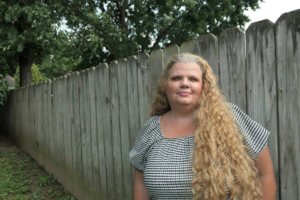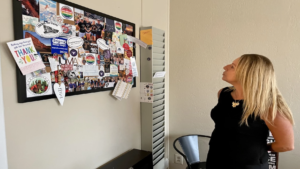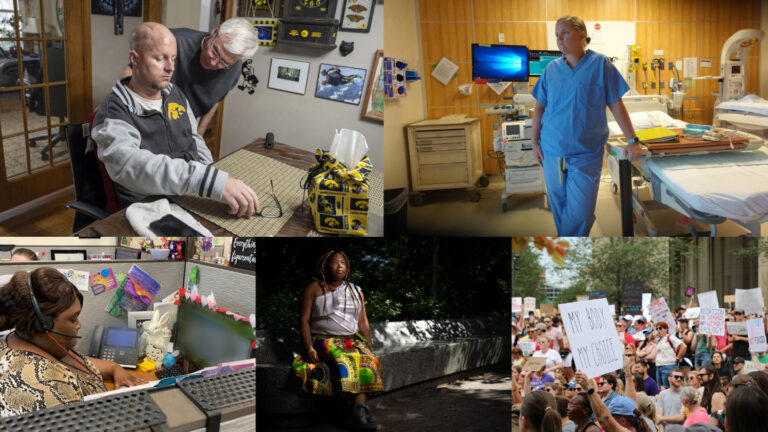The third year of a global pandemic. An uncertain future for reproductive health care. Persistent health care inequities.
This year, Side Effects Public Media reporters delivered high-impact, in-depth stories from across the Midwest and beyond, exploring 2022’s leading health concerns. Side Effects reporters and collaborators shed light on health care disparities, looked for solutions and broke down data to show trends.
Here were the top Side Effects stories of 2022:
Another year of COVID-19

The year started with a new wave of COVID cases spurred by the omicron variant. But slowly, contact tracing and testing efforts scaled back as vaccines, boosters and treatment became widely available. That includes in rural communities with sometimes hard-to-reach immigrant populations.
COVID disruptions rippled through the health care system, and physicians on the front lines of the pandemic expressed concerns about the impact of these disruptions, on early-career physicians in particular.
The fallout of reversing Roe v. Wade
In late June, the U.S. Supreme Court upended decades of health care precedent by reversing Roe v. Wade, the landmark case that guaranteed the constitutional right to an abortion.
The Midwest and surrounding states immediately felt the impact of the decision.
The types of procedures patients could access changed, sometimes from day-to-day. Requests for help from abortion funds skyrocketed. And providers in states restricting abortion worried about the impact on their careers, as well as what an end to legal abortion would mean for the most vulnerable Americans.
Abortion bans are still tangled in the legal system in many states. Side Effects will continue to report on the impact of the changing landscape of abortion care in 2023.
Investigations with national implications

Side Effects reporters tackled many tough subjects in 2022.
Jake Harper and Lauren Bavis continued the work started in the second season of the podcast Sick, with investigations about sexual abuse in prison and concerning suicide watch policies.
Carter Barrett investigated how youth treatment centers across the U.S. are suffering from staff shortages, in collaboration with WFYI education reporter Dylan Peers McCoy.
Natalie Krebs examined how shortages of home health aides create challenges for the growing number of seniors and people with disabilities that need in-home care.
Sebastián Martínez Valdivia explored why pediatricians are worried about the end of the COVID-19 public health emergency, which has allowed children to receive continuous Medicaid coverage throughout the pandemic.
Aprile Rickert examined the link between high maternal mortality rates and restrictive abortion laws. Darian Benson explored the barriers to substance use treatment.
And Farah Yousry reported on the effects of systemic racism on sickle cell disease, as well as how Supreme Court case could end the right of millions of vulnerable Americans to hold states accountable when they do not receive benefits they’re entitled to.
Understanding health care ‘Tradeoffs’

This year, Side Effects partnered with the podcast Tradeoffs to broadcast and publish stories exploring how health care policy affects Americans.
Our collaborative coverage included a preview of the nation’s new mental health crisis line – 988 – ahead of its launch in July.
The Tradeoffs team also reported on how a change to Medicare will help seniors with high drug costs, and how a loophole in the Affordable Care Act makes thousands of people ineligible for federally subsidized health insurance.
Side Effects staff favorites of 2022
Lauren Bavis, digital editor, Side Effects and WFYI: The pandemic exposed a lot of gaps in the prison health care system, but prisons struggle with routine care too – like treating mental health conditions. I liked this story on prison suicide watch companions because it showed that what looked like a solution on the surface was much more complicated.
Darian Benson, health reporter, Side Effects and WFYI: Transportation is one of the biggest barriers to accessing treatment for substance use disorder. For this piece, I took a look at community efforts to help alleviate this issue.

Christine Herman, managing editor, Side Effects and WFYI: Side Effects is part of an ongoing national mental health reporting collaboration led by the Center for Public Integrity and the Rosalynn Carter Mental Health Journalism program. As part of this project, Carter Barrett reported on how some states struggled to plug staffing gaps ahead of the rollout of 988.
Brittani Howell, community engagement specialist, Side Effects and WFYI: I’m always delighted when we’re able to draw stories directly from community input and share them in ways that benefit others. For instance, Carter Barrett’s story about the Hispanic Health Task Force in Seymour became a how-to webinar to help other health clinics build trust in immigrant communities and boost vaccination rates.
Darian Benson’s story about the Indiana Recovery Network’s Lyft partnership came straight out of one of our listening sessions. We’ve heard from several people since it published saying that they learned about the program from the story. At least one of them ended up joining the recovery network!

Natalie Krebs, health reporter, Side Effects and Iowa Public Radio: Interest in home births has increased as more rural hospitals close their labor and delivery units. This was fascinating to me to report. It turns out home births — and certified professional midwives, who are pushing for licensure — are controversial in the medical community.
Sebastián Martínez Valdivia, Side Effects and KBIA: I don’t do a lot of hard science journalism, so this story about how scientists are looking for clues about coronavirus variants in wastewater was pretty fun to report. It was neat to get into the lab with scientists trying to understand how and where the coronavirus is evolving and adapting.
Farah Yousry, health equity reporter, Side Effects and WFYI: This story about the challenges children with sickle cell disease face as they grow up was one of my favorite stories from last year because it touched upon an issue that is rarely reported on, yet is an epitome of health inequities in the U.S. After the story aired, I got great feedback from other reporters telling me they have learned a lot about sickle cell disease and that they’d start paying attention to sickle cell stories in their communities.
Contact digital editor Lauren Bavis at lbavis@wfyi.org. Follow on Twitter: @lauren_bavis. Side Effects Public Media is a health reporting collaboration based at WFYI in Indianapolis. We partner with NPR stations across the Midwest and surrounding areas — including KBIA in Missouri, Iowa Public Radio and WFPL in Kentucky.
9(MDM5MjE5NTg1MDE1Mjk1MTM5NjlkMzI1ZQ000))

